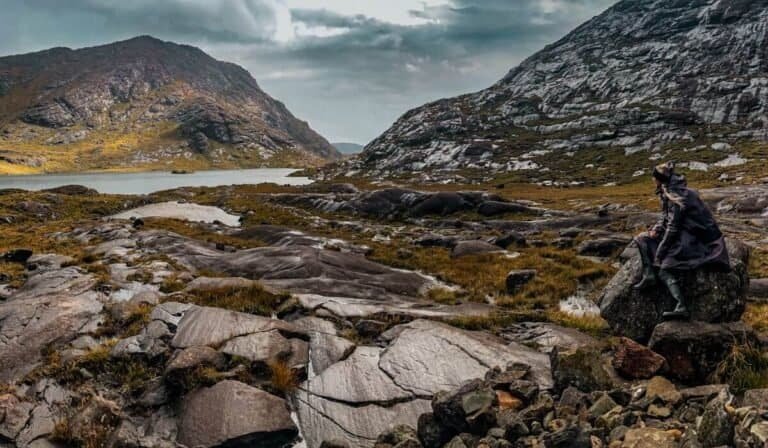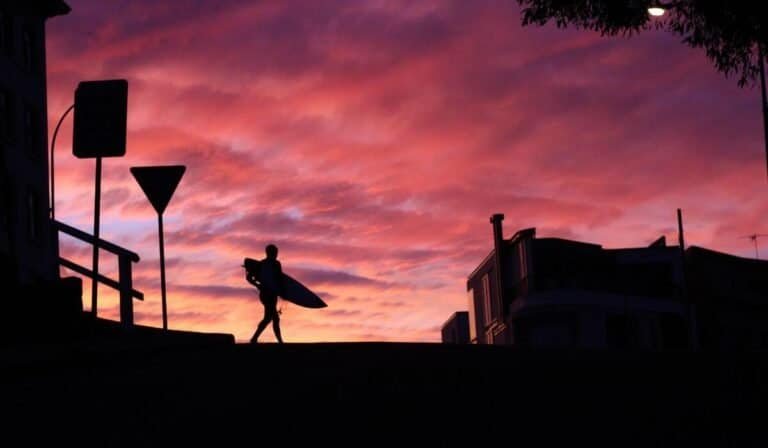Trying To Create An NC500 Itinerary?
Here’s everything you need!
Scotland’s ultimate road trip is the North Coast 500 (NC500). This epic journey takes you through the heart of the Scottish Highlands, showcasing its jaw-dropping landscapes, rich history, and vibrant local culture. With 516 miles of stunning coastline, hidden gems, and enchanting villages, planning your NC500 adventure can be exciting and overwhelming.
Fear not, fellow explorers! We’re here to guide you every step of the way, offering insider tips, must-see stops, and all the inspiration you need to create an unforgettable experience tailored to your interests, budget, and time constraints. So, buckle up and let’s hit the road!
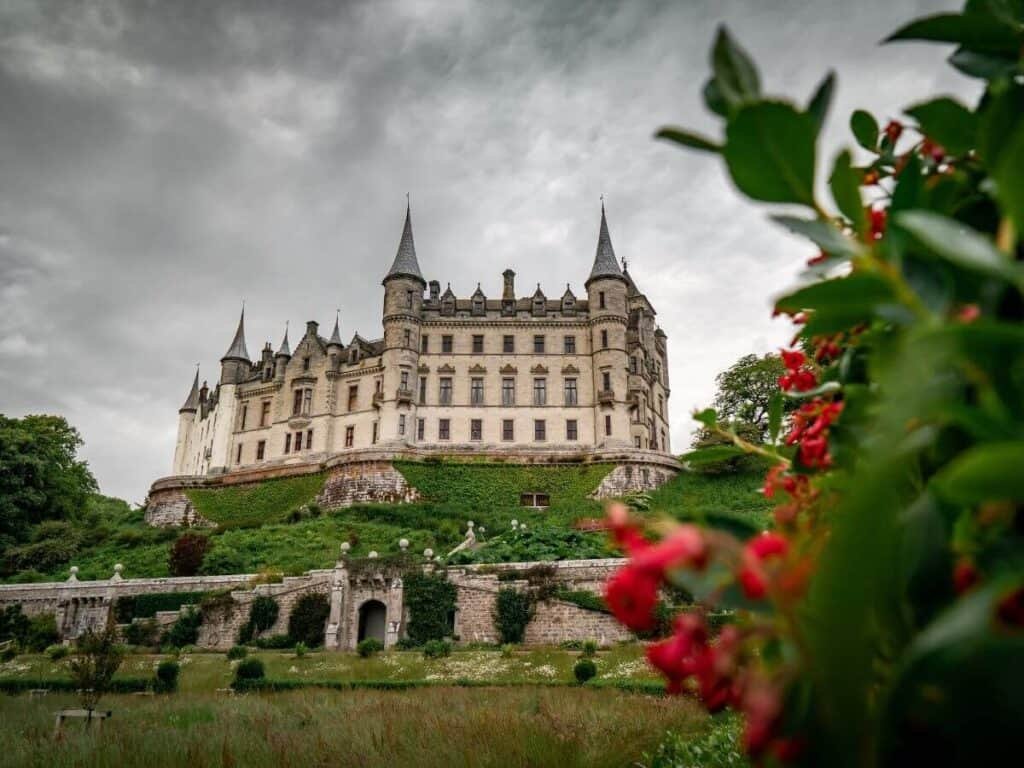
How Long Should I Take On The NC500?
To fully experience the NC500, allocate at least 7-10 days for your trip. This will allow you to explore the local culture, attractions, and outdoor activities without feeling rushed. If your time is limited, a 5-day itinerary can cover the main highlights.
If time isn’t an issue, we would suggest you give this stunning drive as much time as you can. We feel that 2 weeks is a great length of time to see everything at a relaxed pace, while also fitting in a few mountain summits and enough time to enjoy some watersports.
When Is The Best Time To Drive The NC500?
If you can embark on this journey at any time of the year, we would say that mid to late September is the best time to drive the NC500. During the summer months everywhere is overcrowded, passing places are more tricky and you will encounter an unfathomable amount of midges (small mosquito-like bugs).
You can also do this trip in April/May time, but waiting until September gives the water a chance to warm a little, for those wishing to do watersports.
If you are brave enough to tackle this route during winter, keep an eye on the weather and be careful during times when there can be snowfall.
What Is The Hardest Part Of The NC500?
The hardest part of the NC500 is often navigating the narrow, single-track roads that are common along the route, particularly in the more remote areas. These roads require extra caution and patience, as they can be winding and have limited visibility around corners. You’ll also encounter passing places – designated spots for vehicles to pull over and allow oncoming traffic to pass or overtake.
To navigate these challenging roads successfully, keep the following tips in mind:
- Drive slowly and be prepared to slow down further or stop when encountering oncoming traffic.
- Use passing places to allow faster vehicles to overtake or to let oncoming traffic pass safely.
- Be mindful of local wildlife, such as sheep and deer, which may wander onto the roads.
- Stay patient and respectful of other drivers, as everyone is there to enjoy the journey.
- If you are not used to driving on the left side of the road (as required in Scotland), take some time to familiarise yourself with this before embarking on the NC500.
By staying vigilant and following these tips, you’ll be able to tackle the hardest part of the NC500 and fully enjoy the breathtaking scenery and unforgettable experiences along the way.
Can You Do The NC500 In 5 Days?
Yes, you can complete the NC500 in 5 days, although it will require a faster pace and potentially skipping some attractions along the way. To make the most of your time, focus on the main highlights and prioritise the sights and experiences that interest you the most.
You can always skip out the section between Inverness and Applecross (or vice versa) if the most important things you wish to see are along the coast. Unless you have a hire car to return to Inverness of course!
Doing this trip in a Campervan will give you a lot more time and flexibility.

Should I Drive The NC500 Clockwise Or Anticlockwise?
We chose to drive the route anticlockwise for a few reasons:
Our trip started via Northumberland, Edinburgh and Fettercairns. Skye was also on our Scotland itinerary, so we went to Rogie Falls on our way up to Dornoch and skipped out the section between Applecross and Inverness. The most exciting locations were seemingly on the west coast so we wanted to end on a high.
Why we probably should have drove the route clockwise:
Leaving mid-September meant there was a significant drop in temperature towards the end of the month and we had more water activities planned in the latter half of the trip. The east coast was less active and more sightseeing, ideal for colder weather. After weeks on the road and wild camping, we were pretty tired for our jam-packed Skye itinerary.
NC500 Itinerary Planner
We will list this itinerary in an anticlockwise direction, however, if you are planning to drive the route clockwise, just use the planner in reverse.
Where To Start Your NC500 Itinerary
Technically, you can start wherever you like, but most people tend to start and end their NC500 itinerary in Inverness.
The official starting point of the NC500 is the Inverness Castle, you can either start your itinerary here, head to other popular spots in Inverness or just drive straight on through.
Things To Do In Inverness
Inverness, the capital of the Scottish Highlands, offers a wealth of attractions and activities for visitors. Here are some of the best things to see and do in Inverness:
Inverness Castle
Overlooking the River Ness, this 19th-century red sandstone castle is an iconic landmark in Inverness. While the castle itself is not open to the public, you can visit the North Tower for panoramic views of the city and surrounding landscapes.
Loch Ness
Just a short drive from Inverness, Loch Ness is one of Scotland’s most famous lakes, known for its legendary mythical creature, the Loch Ness Monster. Enjoy a scenic boat tour, visit the Loch Ness Centre and Exhibition, or simply take in the breathtaking views along the shore.
Culloden Battlefield
This historic site marks the location of the Battle of Culloden in 1746, the final confrontation of the Jacobite Rising. Visit the interactive visitor centre to learn about the battle and its significance, then explore the battlefield itself, marked with monuments and memorials.
Urquhart Castle
Situated on the banks of Loch Ness, these picturesque ruins date back to the 13th century and offer a fascinating glimpse into Scotland’s medieval history. The castle also provides stunning views of the loch and surrounding countryside.
Inverness Botanic Gardens
Escape the hustle and bustle of the city by visiting these beautiful gardens, featuring lush plant collections, a tropical glasshouse, and peaceful water features.
Inverness Museum and Art Gallery
Delve into the history and culture of the Scottish Highlands through a variety of exhibits, including archaeological artefacts, local artwork, and natural history displays.
River Ness And Ness Islands
Take a leisurely stroll along the picturesque River Ness, crossing the charming footbridges that lead to the peaceful Ness Islands, a group of small islands in the middle of the river.
Eden Court Theatre
This popular entertainment venue hosts a wide range of performances, including theatre, dance, music, and film screenings. Check their schedule to see what’s on during your visit.
Victorian Market
Located in the heart of Inverness, this historic indoor market features a variety of shops and eateries, offering everything from locally made crafts to delicious food.
Whisky Tasting
As you’re in the heart of whisky country, take advantage of the opportunity to sample some of Scotland’s finest single malts at local pubs or by visiting nearby distilleries, such as Glen Ord Distillery or Tomatin Distillery.
Dolphin Watching
A short drive from Inverness is the famous dolphin watching spot of Chanonry Point, located on the Black Isle in Scotland, near the town of Fortrose. It is considered one of the best onshore locations in the UK to observe bottlenose dolphins up close.
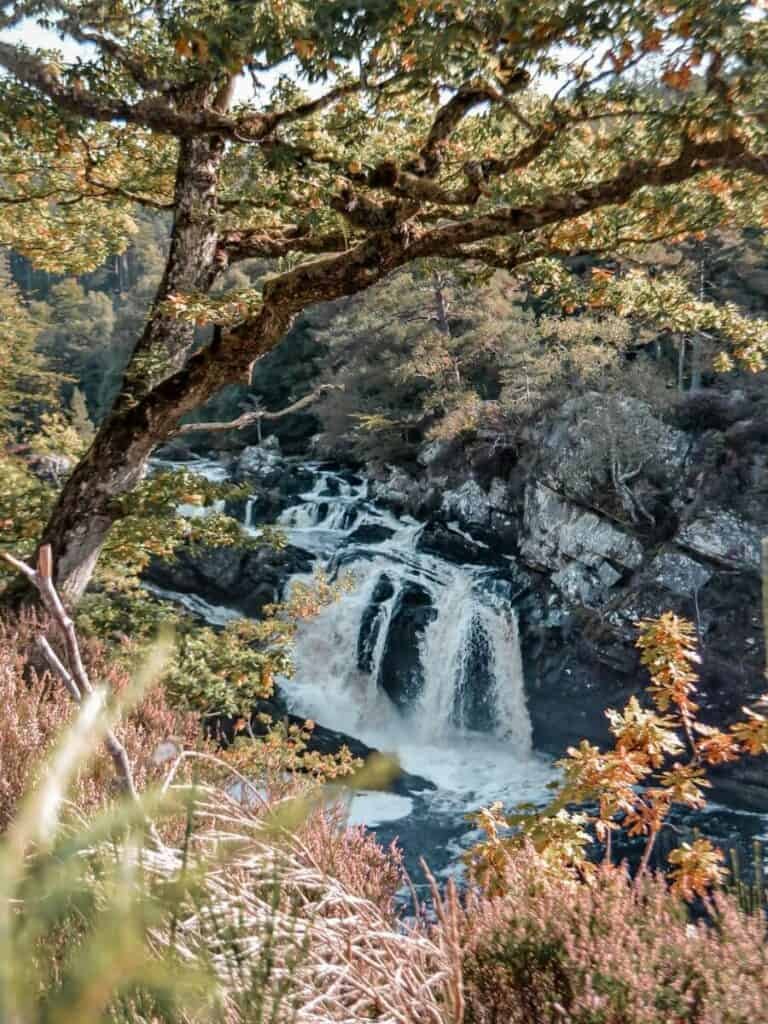
Inverness > Beauly (15 miles / 24 km)
Depart Inverness and head west on the A862 towards Beauly. The drive should take around 20-30 minutes. We drove through here with no intention of stopping, but when I spotted a tree that looked like a Whomping Willow in the Beauly Priory, I had to get out for a closer look.
Beauly Priory: A historic 13th-century monastery, now in ruins, offering a glimpse into Scotland’s ecclesiastical past.
Campbell’s of Beauly: A traditional Scottish tailor and outfitter, perfect for picking up some high-quality souvenirs or clothing items.
Take a stroll around the village square and visit local shops, cafes, and galleries.
Beauly > Dingwall (9 miles / 14 km)
Dingwall Museum: Learn about the local history and heritage of the town and surrounding area.
Hector MacDonald Memorial: A monument dedicated to a local hero and soldier, Sir Hector MacDonald.
Explore the town centre, which offers a variety of shops, cafes, and restaurants.
Dingwall > Tain (25 miles / 40 km)
Glenmorangie Distillery: Take a tour of this famous distillery and sample some of Scotland’s finest single malt whiskies.
Tain Through Time: A heritage centre showcasing the history and culture of the town, including the Tain Museum and Collegiate Church of St. Duthus.
Tarbat Discovery Centre: In the nearby village of Portmahomack, is an interactive museum offering insights into the area’s Pictish history and archaeological discoveries.
Struie Hill: Enjoy the beautiful rusty tones that look like a sleeping lion on the hills surrounding Struie Road or go for a hike up Struie Hill on this 4-mile (6.5km) trail.
From Struie Hill looking at Dornoch Firth towards Bonar Bridge, to the left of the bridge in front of the big red building is a picnic spot. This also looked like a great place to park up for the night, but check your Park4Night app for up-to-date information.
Tain > Dornoch (9 miles / 14 km)
Dornoch Cathedral: A beautiful and historic 13th-century cathedral located in the heart of the town.
Royal Dornoch Golf Club: One of the world’s top-rated golf courses, perfect for golf enthusiasts.
Dornoch Beach: A beautiful golden sand beach that will make you question if you are still in Scotland. If beach camping is on your agenda Dornoch Beach and its star-lit sky (on a clear night) should be on your itinerary.
Dornoch > Brora (16 Miles / 26 km)
Dunrobin Castle: On the way to Brora is a beautiful mid-19th-century, fairytale castle. Dunrobin Castle is open to public visits for an admission fee.
Brora Beach: Wander along this beautiful stretch of coastline, ideal for beachcombing and wildlife spotting.
Clynelish Distillery: Tour this historic distillery, where you can learn about the whisky-making process and sample some fine single malts.
Brora Heritage Centre: Delve into the village’s history, including its role in the Industrial Revolution and the Highland Clearances.
💡Top Tip: There are no petrol stations between Brora and Wick, keep an eye on your fuel consumption and pre-plan your fuel stops.
Brora > Helmsdale (11 Miles / 18 km)
Timespan Museum and Arts Centre: Learn about the local history, culture, and art at this award-winning museum and gallery.
Helmsdale Harbour: Take a walk around this picturesque harbour, a perfect spot for photography enthusiasts.
The Emigrants Monument: Pay homage to the thousands of Highlanders who left their homes during the Highland Clearances at this poignant memorial.
Helmsdale > Dunbeath (14 miles / 22 km)
Dunbeath Castle: Admire this impressive 17th-century castle perched on a cliff overlooking the North Sea (Note: The castle is privately owned and not open to the public, but can be viewed from a distance).
Dunbeath Heritage Centre: Explore the local history and culture of Dunbeath and its surrounding area.
Dunbeath Strath: Enjoy a scenic walk along this beautiful river valley, taking in the diverse flora and fauna.
Dunbeath > Wick (20 Miles / 32 km)
The Grey Cairns Of Camster: The Camster Cairns provide a fascinating insight into the burial practices and architectural skills of the Neolithic people who once inhabited the region.
Whaligoe Steps: The name Whaligoe is a combination of Whale and Goe. Goe is Scottish for fishing port and Whales used to regularly be sighted and even washed up in this little fishing cove.
Wick Heritage Centre: Immerse yourself in the town’s fascinating history, including its role in the herring industry and connections to the Viking Age.
Old Pulteney Distillery: Tour one of the most northerly distilleries on the Scottish mainland, and sample its award-winning whisky.
Castle Sinclair Girnigoe: Explore the atmospheric ruins of this 15th-century castle, perched atop dramatic cliffs overlooking the sea.
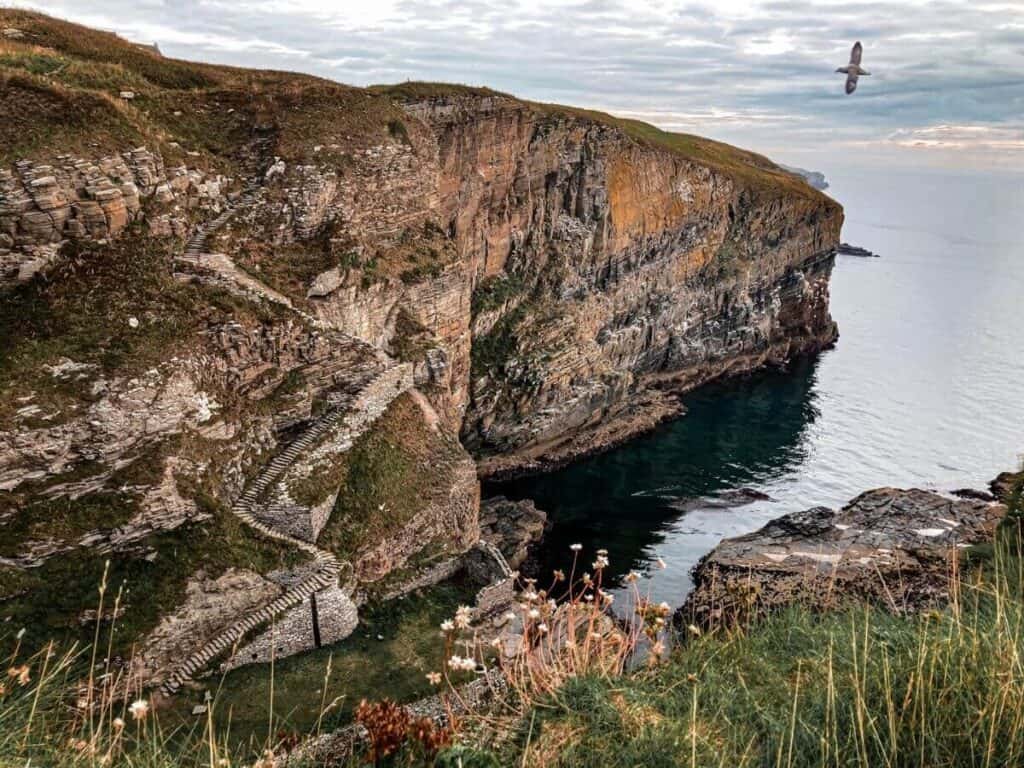
Wick > John o’ Groats (16 miles / 26 km)
Duncansby Head: Admire the impressive sea stacks and enjoy a short coastal walk for panoramic views.
John o’ Groats: Visit this iconic village, known as the most northeasterly point on the British mainland.
Caithness Seacoast: Embark on a thrilling boat tour along the Caithness coast, offering the opportunity to spot wildlife and admire stunning sea cliffs.
Dunnet Head: Explore the most northerly point of mainland Britain, offering stunning views of the surrounding coastline.
John o’ Groats > Thurso (19 miles / 30 km)
Dunnet Bay Distillery: Visit this artisan distillery, home to Rock Rose Gin and Holy Grass Vodka.
Mary Ann’s Cottage: Visit this well-preserved 19th-century Croft house for a glimpse into traditional Highland life.
Caithness Horizons Museum: Learn about the history and culture of Caithness through interactive exhibits.
Scrabster Harbour: Stroll along this bustling harbour and watch the boats come and go.
Old St Peter’s Church: Visit this historic church and graveyard, dating back to the 12th century.
Thurso > Bettyhill (43 miles / 69 km)
Strathy Beach: Relax on this remote sandy beach, perfect for a break and a scenic walk.
Farr Stone: Visit this Bronze Age standing stone located near the village of Bettyhill.
Strathnaver Museum: Dive into the local history at this museum located in a former church.
Bettyhill > Tongue (33 miles / 53 km)
Borgie Forest: Wander through this enchanting woodland, home to diverse flora and fauna.
Coldbackie Beach: Admire the breathtaking views and take a stroll along this picturesque beach.
Castle Varrich: Hike up to the ruins of this ancient castle, offering panoramic views of the Kyle of Tongue.
Tongue Bay: Take a leisurely walk along this scenic bay and enjoy the stunning landscape.
Ben Loyal: Embark on a hike to the summit of this distinctive mountain, known as the “Queen of Scottish Mountains.”
Tongue > Durness (30 miles / 48 km)
Borgie Forest: Wander through this enchanting woodland, home to diverse flora and fauna.
Ben Hope: Take on the 4.75 miles (7.5 km) hike to the top of Scotland’s most northerly Munro.
Smoo Cave: Explore this fascinating sea cave with a large freshwater chamber.
Sango Sands Beach: Relax on this beautiful sandy beach, perfect for a break and a scenic walk.
Cocoa Mountain Shop: Chocoholics should definitely add this to their NC500 Itinerary, sample some cocoa goodies and the proudly advertised “Best Hot Chocolate”.
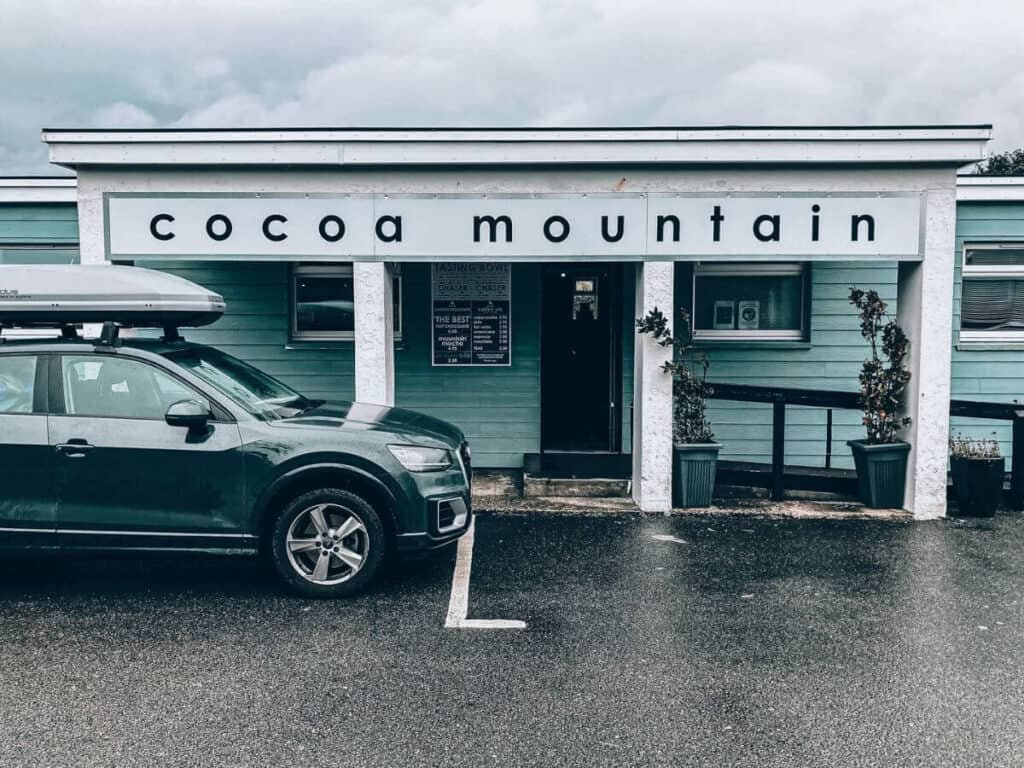
Durness > Scourie (24 miles / 39 km)
Balnakeil Beach: Stroll along this picturesque beach, taking in the stunning coastal views.
Faraid Head: Enjoy a coastal walk to this headland, offering panoramic views and birdwatching opportunities.
Handa Island Wildlife Reserve: Take a boat trip to this island reserve, home to thousands of seabirds and dramatic cliffs.
Sandwood Bay: Take this remote coastal path on an 8 mile roundtrip hike to this stunning beach.
Scourie Beach: Relax on this picturesque sandy beach and enjoy the surrounding scenery.
Scourie Headland Walk: Embark on a short walk around the headland for breathtaking views of the coastline.
Hermit’s Castle: Visit this tiny, intriguing structure made of concrete, located near Achmelvich Beach.
The valleys from Durness to Scourie will leave you wondering if you are passing through Middle Earth.
Scourie > Drumbeg (20 miles / 32 km)
Kylesku Bridge: Admire this striking modern bridge spanning Loch a’ Chàirn Bhàin.
Kylesku: Keep an eye out for wild dear on the road near Kylesku, for an up-close gander at Bambi, this area is great for wild camping too. But please be respectful and don’t disturb the wildlife.
Drumbeg Viewpoint: Stop at this viewpoint for stunning vistas of the rugged coastline and surrounding landscape.
Drumbeg > Lochinver (14 miles / 22 km)
Clashnessie Falls: If the weather hasn’t been too dry these falls are often magnificent.
Clachtoll Beach: Enjoy a break at this beautiful sandy beach, perfect for a leisurely walk.
Flossie’s Beach Store: The perfect brunch stop. Grab your classic Scottish butties here.
Achmelvich Beach: Achmelvich beach offers a campsite and wild camping. The multiple beach coves are a great place for sea kayaking, paddle boarding and snorkelling. The smooth beige sand and clear blue waters will have you questioning whether or not you are still in Bonnie Scotland.
Stoer Lighthouse: Visit this historic lighthouse and take in the breathtaking views of the coastline.
Inverkirkaig Falls: Take a short hike to these impressive waterfalls, surrounded by lush greenery.
Drumbeg Loop: Drive this scenic route around the Drumbeg Peninsula, offering stunning views of the coast and mountains. The road from Kylesku to Drumbeg is a singletrack road and not for the faint-hearted. Take these roads cautiously, one stretch is a gradient of 25%.
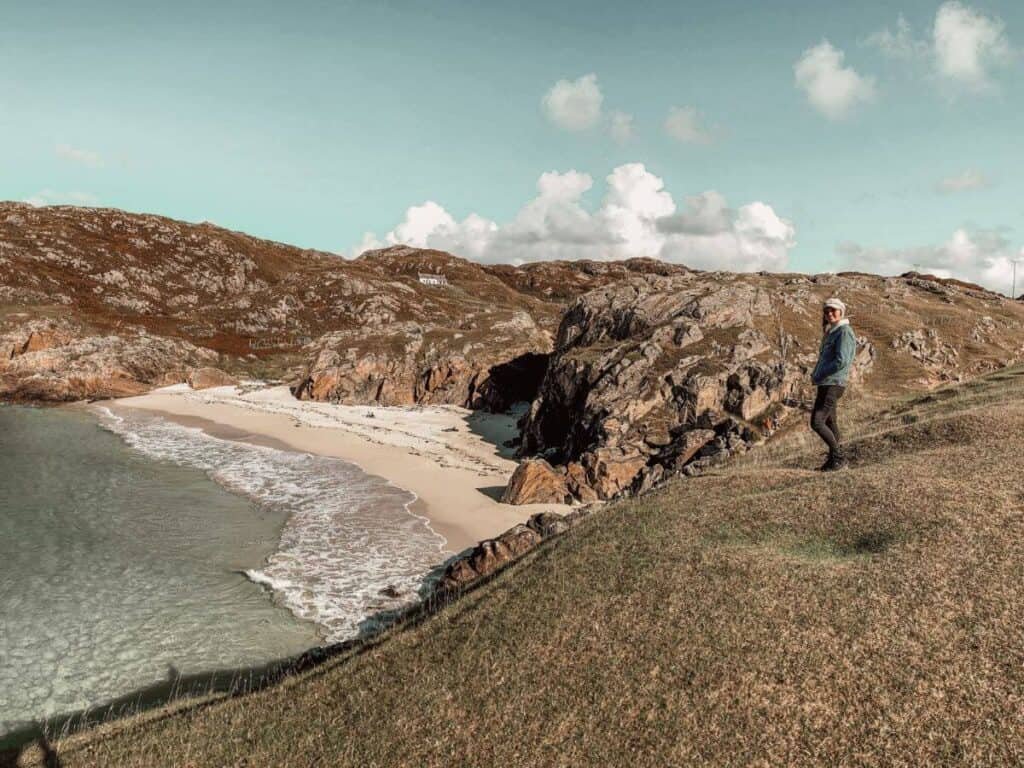
Lochinver > Inchnadamph (13 miles / 21 km)
Ardvreck Castle: Visit the ruins of this 16th-century castle, situated on the shores of Loch Assynt. The castle offers a glimpse into Scotland’s turbulent history and spectacular views of the surrounding landscape.
Loch Assynt: Spend the afternoon relaxing by the serene waters of Loch Assynt, where you can enjoy picnicking, fishing, or simply taking in the stunning scenery.
Inchnadamph > Elphin (9 miles / 14 km)
Bone Caves: Hike to the fascinating Bone Caves, located about 2 miles (3.2 km) from Inchnadamph. These limestone caves hold archaeological treasures, including the remains of prehistoric animals.
Elphin Tea Rooms and Gallery: Browse the artwork by local artists at this delightful tea room and gallery, where you can also enjoy a cup of tea and a slice of cake.
Elphin > Ullapool (15 miles / 24 km)
Knockan Crag National Nature Reserve: Visit this fascinating geological site, where you can explore walking trails, enjoy panoramic views, and learn about the area’s ancient history at the visitor centre. The car park offers overnight parking, a small wild camping area, picnic tables, toilets and a shower.
Stac Pollaidh: We underestimated Stac Polliadh for its views. The climb is pretty easy and has a well marked out footpath, the rewards for this simple climb are beyond comprehension. If you only add one hike to your NC500 Itinerary, make it this one.
Ullapool Museum: Discover the rich history of this coastal village at the Ullapool Museum, housed in a beautifully restored Thomas Telford Parliamentary Church.
Ullapool Harbour: Round off your day with a leisurely stroll along the picturesque Ullapool Harbour, where you can watch fishing boats come and go, dine at one of the many seafood restaurants, or simply soak up the atmosphere.
Ullapool: This town is pretty geared up for campers. It offers a huge campsite, a laundrette, a large free overnight car park next to a Tesco Extra and a public shower on West Argyle Street.
Also on this street, you will find the Seafood Shack, an award-winning street food van offering a selection of restaurant quality fish dishes. If fish isn’t your thing, across the street is The Ceileigh Place to grab a bite and a cold one.
There is a chippy (Fish and Chip shop) on Quay Street and a Cafe on the A893 which joins Quay Street and West Shore Street. Next to The Seafood Shack is an Outdoor shop filled with hiking, climbing and camping equipment. If you need to pick up any maps, camping gas, or equipment this is the place to go.
Ullapool > Aultbea (44 miles / 70 km)
Corrieshalloch Gorge: Begin your day with a visit to this awe-inspiring gorge, featuring a dramatic suspension bridge and a stunning waterfall known as the Falls of Measach.
Russian Arctic Convoy Exhibition: Learn about the fascinating history of the Arctic convoys during World War II at this informative museum.
Aultbea Beach: Spend some downtime relaxing on the pebble beach at Aultbea, taking in the beautiful coastal scenery and watching for wildlife.
Aultbea > Gairloch (12 miles / 19 km)
Inverewe Garden: Visit this remarkable subtropical garden, filled with exotic plants and boasting beautiful views of Loch Ewe.
Gairloch Marine Wildlife Centre & Cruises: Here you can learn about the local marine life and even embark on a wildlife-watching cruise.
Gairloch Heritage Museum: Discover the history of Gairloch and its people at this engaging museum, featuring exhibits on local industries, archaeology, and more.
Big Sands Beach: Take a leisurely stroll along the beautiful Big Sands Beach, offering sweeping views of the surrounding mountains and coastline. Big Sands campsite offers great facilities and parking for non-campers.
Red Point: Head to this stunning location to catch breathtaking sunsets.
Gairloch > Kinlochewe (20 miles / 32 km)
Beinn Eighe National Nature Reserve: Begin your day with a visit to this spectacular nature reserve, offering walking trails through ancient pinewoods, beautiful lochs, and breathtaking mountain landscapes.
Loch Maree: Spend some time exploring the serene waters of Loch Maree, known for its diverse wildlife, including black-throated divers and golden eagles.
Kinlochewe Viewpoint: Head to this stunning viewpoint, which offers panoramic vistas of the surrounding mountains, including the impressive Beinn Eighe massif.
Kinlochewe > Applecross (32 miles / 51 km)
Beinn Eighe & Liathach: Hike one (or both if you have time) of the most famous peaks in the Torridons. Summiting the two Munros of Beinn Eighe should take roughly 7-9 hours while Liathach is roughly 8-10 hours. These hikes are great additions to your NC500 Itinerary.
Bealach na Bà: Drive along this famous mountain pass, boasting hairpin bends and incredible views of the surrounding landscape.
Applecross Heritage Centre: Learn about the history of the Applecross Peninsula at this informative heritage centre, featuring exhibits on local archaeology, culture, and wildlife.
Applecross Walled Garden: Stroll through this beautiful garden, showcasing a variety of plants and offering stunning views of the nearby mountains.
Applecross Peninsula Drive: If you have time the loop around the coast of the Applecross peninsula is absolutely stunning and well worth the extra miles.
The best way to drive the Applecross Peninsula, if you are going anticlockwise, is to head South from Sheildag towards Tornapress. Do a clockwise circle on the Bealach na Ba Pass until you reach Shieldaig again in a full circular route.
We gave an entire day to the route, we wanted to do it slowly and stop to get out or take pictures at every opportunity, there were many. Take the time to soak in the views of the Isle of Raasay and the Cullins of Skye.
Take it easy along the road past Applecross and keep an eye out for Highland cows. Most articles will tell you this is a knarly drive, but it’s no different to all of the other singletrack routes in Scotland and certainly not as sketchy as roads like the Hard Knott Pass in the Lake District.
Drive slowly and use the passing places available to avoid oncoming vehicles.
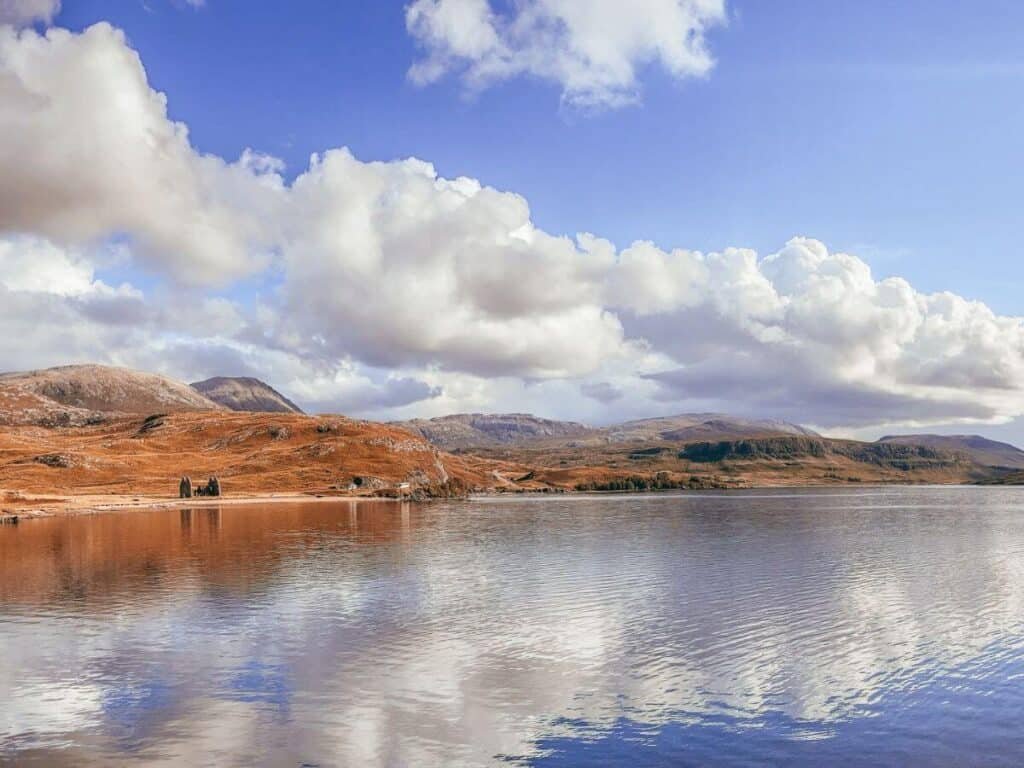
Applecross > Lochcarron 12 miles (19 km)
Attadale Gardens: Visit these beautiful gardens, featuring a variety of plant collections, sculptures, and stunning views of the surrounding landscape.
Lochcarron Weavers: Discover the art of traditional Scottish weaving at this working mill, where you can browse a wide range of tartans and other woollen products.
Strome Castle: Head to the ruins of this 15th-century castle, offering spectacular views of Loch Carron and the surrounding mountains.
Lochcarron > Inverness (63 miles / 101 km)
Rogie Falls: This is a beautiful spot to visit in the morning, the soft glow of the golden morning light adds to the beauty of the waterfall and leaping salmon.
Victorian Spa Pavilion: Visit this beautifully restored Victorian pavilion, which hosts a variety of events and exhibitions throughout the year.
Strathpeffer Pump Room: Learn about the history of this spa town at the Pump Room, where visitors once came to “take the waters” for their health benefits.
Castle Leod: Explore the grounds of this 16th-century castle, home to the Earl of Cromartie and open to the public on select days throughout the year.
5-Day NC500 Highlights Itinerary
This 5-day NC500 itinerary covers the main highlights of the NC500, starting and ending in Inverness, and travelling anticlockwise.
Day 1: Inverness > John O’Groats (120 miles / 193 km)
Dunrobin Castle: A magnificent stately home with beautiful gardens, open for guided tours and falconry displays.
Whaligoe Steps: A historic set of 365 steps that descend to a small harbour, offering stunning views of the coastline.
Castle Sinclair & Girnigoe: From the road, this looks like a small abandoned building but when getting up close this castle grounds expands from sea level and up the cliff top.
Duncansby Stacks: Impressive sea stacks located near Duncansby Head, accessible via a short coastal walk.
Day 2: John O’Groats > Durness (90 miles / 144 km)
Dunnet Head: The most northerly point of mainland Britain, offering panoramic views of the surrounding coastline and a chance to spot seabirds and marine life.
Strathy Bay: Take a little downtime on this stunning north coast beach.
Smoo Cave: A fascinating sea cave with a large freshwater chamber, accessible by guided tours or a short walk from the car park.
Day 3: Durness > Clashnessie > Ullapool (102 miles / 164 km)
Ardvreck Castle: A 16th-century ruin located on the shores of Loch Assynt, offering stunning views and a glimpse into Scotland’s past.
Kylesku Bridge: A striking modern bridge spanning the Loch a’ Chàirn Bhàin, providing a scenic viewpoint.
Clashnessie Falls: Park up near the beach on your way through Clashnessie and take a short stroll up to the falls.
Flossie’s Beach Store: Stop for a butty and a cuppa at Flossie’s.
Achmelvich Beach: Have a short break at this beautiful white sand beach.
Day 4: Ullapool > Gairloch (55 miles / 88 km)
Stac Pollaidh: Hike this relatively easy mountain for extremely rewarding panoramic views from the top. This route is 2.75 miles (4.5km) and takes roughly 2-4 hours, it’s one of our favourite hikes in Scotland.
Lael Forest Garden: A beautiful woodland garden with a variety of tree species from around the world.
Corrieshalloch Gorge and Falls of Measach: A dramatic gorge with a suspension bridge, offering stunning views of the 150-foot waterfall.
Day 5: Gairloch > Applecross > Inverness (127 miles / 204 km)
Bealach na Bà: This is one of the most beautiful mountain passes in the UK, in an absolutely stunning location. This was definitely one of our favourite driving sections on the NC500.
Rogie Falls: A picturesque waterfall and forest walk, perfect for a short break and photo opportunity.
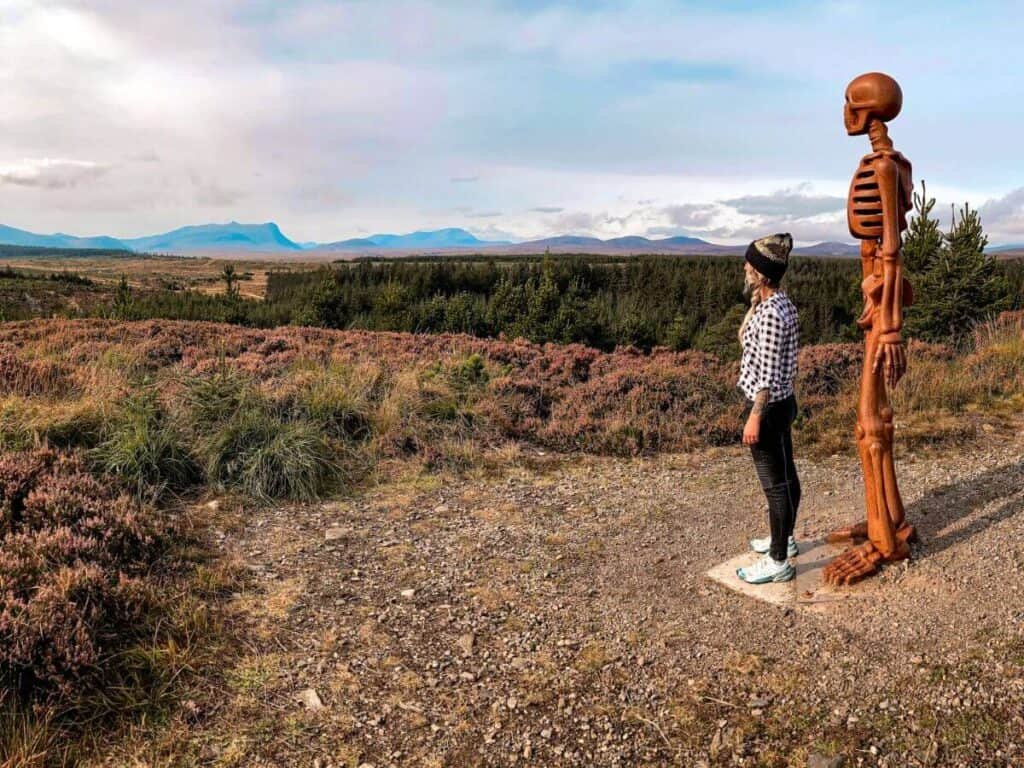
10-Day NC500 Hiking & Highlights Itinerary
Embark on a thrilling 10-day journey along the NC500. This itinerary covers the main highlights of the NC500, including hiking adventures at Ben Hope and Stac Pollaidh, starting and ending in Inverness, and travelling clockwise.
Day 1: Inverness > Chanonry Point > Beauly > Tain (64 miles / 103 km)
Chanonry Point: Head out early to look for Dolphins at this famous Dolphin spotting location on the Black Isle. Check the tide times, the best viewing time tends to be 1hr after low tide.
Fyrish Monument: Take a short hike to this unique monument, offering panoramic views of the Cromarty Firth.
Glenmorangie Distillery: Tour this renowned distillery and sample its award-winning single malt whisky.
If you have time take a drive through the picturesque village of Beauly, and stroll through the streets of Inverness.
Day 2: Tain > John O’Groats (85 miles / 137 km)
Whaligoe Steps: A historic set of 365 steps that descend to a small harbour, offering stunning views of the coastline.
Castle Sinclair & Girnigoe: From the road, this looks like a small abandoned building but when getting up close this castle grounds expands from sea level and up the cliff top.
Day 3: John O’Groats > Strathy Bay (41 miles / 66 km)
Spend the day exploring the northernmost points of mainland Britain:
Duncansby Stacks: Take a short coastal walk to admire these impressive sea stacks near Duncansby Head. On the path to Duncansby Stacks, there’s a rope leading down the cliffs to the beach. The way down is fairly steep but more than achievable for most.
Dunnet Head: Visit the most northerly point of the mainland UK with spectacular 360-degree views of the peninsula, overlooking nearby Lochs and the Atlantic Ocean.
Thurso: The small town of Thurso offers Caithness Wildlife Tours. It also has a Lidl and was our stop to top up on our shopping. If you’re wild camping, stock up here as there isn’t much in the way of cheap eats between here and Ullapool.
💡Top Tip: The Tongue Hotel in Tongue offers affordable lunch options and the Spar in Durness has quick pick-up options and hot coffee. Other than these, there isn’t much on the route, so grab more than you think you need in Thurso just to be on the safe side. Also, fill up your petrol here, there are only a few small pay-at-the-pump fuel stops between here and Ullapool.
Strathy Bay: This is a great spot to wind down for the evening and offers excellent wild camping facilities.
Day 4: Strathy Bay > Ben Hope (37 miles / 59 km round trip)
Ben Hope: The most northerly Munro in Scotland with breathtaking views and cascading waterfalls. This route is 4.75 miles (7.5km) and takes roughly 4-6 hours.
Remember to pack accordingly for any hike, sturdy footwear, layers and a waterproof outer layer are the minimum requirements for a hike like this. We had lovely calm weather at the base and hectic winds at the summit. Always be prepared and check the weather forecasts before setting off.
If you’re in a campervan or are wild camping, there are plenty of spots to pitch up for the night at the base on Ben Hope.
Day 5: Durness > Blairmore (22 miles / 35 km)
Smoo Cave: Explore this fascinating sea cave with a large freshwater chamber, accessible via guided tours or a short walk from the car park.
Sandwood Bay: Embark on this 8-mile (round trip) hike to one of Scotland’s most remote beaches, then reward yourself with some downtime or a picnic on the beach.
Day 6: Blairmore > Drumbeg > Achmelvich 52 miles (84 km)
Kylesku Bridge: Admire this striking modern bridge spanning Loch a’ Chàirn Bhàin.
Drumbeg Peninsular: The road from Drumbeg to Kylesku is a singletrack road and not for the faint-hearted. Take these roads cautiously, one stretch is a gradient of 25%. The rollercoaster roads lead to a viewing point of Loch Drumbeg.
Clashnessie Falls: Park up near the beach on your way through Clashnessie and take a short stroll up to the falls. Once you reach the path to the falls there are two routes. The righthand route is through a shoe submerging muddy path and the left requires you to cross the flowing river on stepping stones precariously. Whichever way you choose make sure you are wearing sturdy water/splashproof footwear. (Unless you visit at a particularly dry time of year)
Flossie’s Beach Store: Stop for a butty and a cuppa at Flossie’s.
Day 7: Achmelvich > Lochinver 4 miles (6 km)
Achmelvich Beach: Take a relaxing break at this stunning white sand beach and enjoy the unbelievable crystal blue water.
Ardvreck Castle: Visit the ruins of this 16th-century castle located on the shores of Loch Assynt. We had a lovely kayak on the loch and a picnic on the shores.
Day 8: Lochinver > Stac Pollaidh > Gairloch (85 miles / 136 km)
Stac Pollaidh: Hike this relatively easy mountain for extremely rewarding panoramic views from the top. This route is 2.75 miles (4.5km) and takes roughly 2-4 hours, it’s one of our favourite hikes in Scotland.
The path follows a loop, to the left is a gentle climb and parts of the path become quite boggy. The righthand path is dry and a little steeper. When reaching the top of the walking path you are greeted with the outcrop of rock that’s made Stac Polliadh Insta Famous.
But beyond the walking path are lots of scramble routes which eventually lead to the true summit. Most people were happy to grab their Insta photo and head back down, we decided to explore the paths to see if we could reach the summit.
The scrambles varied, most of them being fairly easy, aside from one short vertical pitch, with a sketchy drop on either side right before the summit. If you take the scramble route to the true summit be very careful and sure of yourself, a small slip here could be a long tumble down.
Gairloch: Head to Gairloch for the night, ready for another hiking day tomorrow.
Day 9: Gairloch > Beinn Eighe > Torridon (30 miles / 48 km)
Beinn Eighe: Tick off two Munros on this full-day hike in the Torridons! A trail of 11 miles (18 km) should take roughly 7-9 hours.
Head to Torridon for the night and a final driving day tomorrow.
Day 10: Torridon > Applecross Peninsular > Inverness (113 miles / 181 km)
Applecross: Most people drive the Applecross Pass, Bealach na Bà, we decided to loop the entire peninsular, this will add miles to the journey so if you would like to make it shorter you absolutely can, however, the coastal drive is definitely worth it if you have time.
Rogie Falls: Take a short walk to the suspension bridge to see these picturesque waterfalls, try to spot the leaping salmon and enjoy the surrounding woodland.
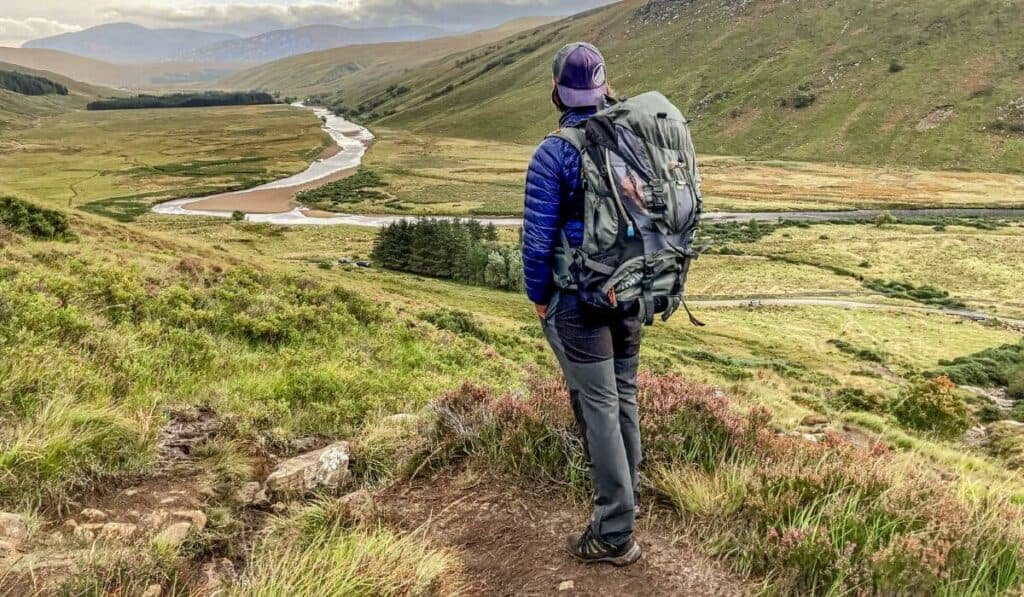
Is The NC500 Worth It?
We can confidently say that the NC500 is absolutely worth it for those seeking a memorable and diverse road trip experience. After spending years travelling abroad, we were both shocked at how stunning the Scottish Highlands were, Scotland has now become one of our favourite travel destinations. The NC500 has gained international recognition as one of the most spectacular road trips in the world, offering a mix of stunning landscapes, rich history, and authentic local experiences.
The NC500 takes you through the heart of the Scottish Highlands, showcasing its breathtaking beauty and vibrant culture. Here are a few reasons to take on this amazing road trip:
Stunning scenery: From dramatic mountain passes like Bealach na Bà to pristine beaches such as Sandwood Bay, the NC500 offers an ever-changing landscape that will leave you in awe.
Historic sites: Discover ancient castles like Ardvreck Castle and fairy-tale-like Dunrobin Castle, which provide a glimpse into Scotland’s rich past.
Unique local experiences: Visit traditional distilleries like Glenmorangie and Old Pulteney, where you can sample exquisite Scotch whiskies, or explore artistic communities like Balnakeil Craft Village for a taste of local creativity.
Delicious food options: Indulge in fresh seafood, local cheeses, and farm-to-table specialities at renowned eateries like the Applecross Inn and Kylesku Hotel.
However, there are a few potential drawbacks to consider before embarking on your NC500 itinerary:
Narrow roads: Single-track roads in some sections can be challenging for inexperienced drivers or those unfamiliar with driving on the left side of the road.
Weather: Scotland’s weather can be unpredictable, so be prepared for rain and changing conditions, even during the summer months.
Time constraints: To fully enjoy the NC500, it’s recommended to allocate at least 7-10 days for the journey, which may not be feasible for everyone.
North Coast 500 Beaches
The NC500 is no stranger to incredible beaches. Some of them are so pristine with clear blue water and white sand, that it’s easy to forget that you are in fact in the UK. Each beach area along the route offers unique natural beauty, exciting activities, and convenient facilities to ensure an unforgettable experience for all. Here are our top 5 beaches to add to your NC500 itinerary:
Sango Bay
Sango Bay is a stunning beach located in the village of Durness, on the northwest coast of Scotland. The bay is known for its striking coastal landscapes, pristine sands, and clear blue waters.
Beach and Surroundings: Sango Bay features a mix of golden sand and rocky outcrops, set against the dramatic backdrop of towering cliffs. The beach is divided into two parts – Sango Sands to the east and Sango Bay West to the west – both offering breathtaking views and ample space for relaxation. Rock pools can be found at low tide, providing opportunities for exploration and wildlife spotting.
Wildlife and Flora: The bay and its surrounding area are home to various wildlife species, such as seabirds, seals, and occasionally dolphins or whales. The coastal cliffs serve as nesting sites for birds like guillemots, razorbills, and kittiwakes. The area also boasts diverse plant life, including wildflowers and coastal grasses.
Activities: Sango Bay is perfect for a range of activities, including sunbathing, swimming, walking, and beachcombing. The bay’s exposed location can sometimes create suitable conditions for surfing, particularly during the winter months when swells are more consistent.
Access and Facilities: Sango Bay is easily accessible, with parking available at the nearby Sango Sands Oasis campsite. From the parking area, a short walk leads you to the beach. Facilities at the campsite include restrooms, showers, a shop, and a bar. There is also a local pub, The Smiddy, within walking distance of the bay.
Achmelvich Beach
Achmelvich Beach, close to Lochinver, is a stunning white sandy beach with crystal-clear waters that wouldn’t look out of place in the Caribbean. This Blue Flag beach offers a range of activities, including kayaking, windsurfing, and coastal walks. There’s a campsite nearby, as well as public restrooms and a seasonal food truck offering delicious snacks.
Beach and Surroundings: The beach at Achmelvich is characterized by its fine, white sand and sheltered bay, providing a perfect setting for relaxation and water activities. The area is surrounded by rolling hills and rocky cliffs, creating a picturesque backdrop for visitors to enjoy. At low tide, rock pools can be found along the shore, offering opportunities for exploration and wildlife spotting.
Activities: Achmelvich Beach is an ideal spot for various activities such as swimming, sunbathing, kayaking, and paddleboarding. The clear waters and sheltered location make it particularly suitable for families with children. Additionally, the beach is a popular destination for walkers, with several coastal trails starting from the beach area, including the walk to the nearby Hermit’s Castle – a small stone hut built into the rocks.
Access and Facilities: Achmelvich Beach can be reached by car, with a small parking area available near the beach. Keep in mind that the road leading to the beach is narrow and winding, so drive cautiously. There are basic facilities available, including public restrooms and a seasonal snack bar. The nearest village, Lochinver, offers more amenities such as shops, restaurants, and accommodation options.
Camping and Accommodation: There’s a campsite close to the beach, Achmelvich Beach Youth Hostel, which offers camping pitches, as well as dormitory-style accommodation. The campsite operates during the summer months and provides basic facilities for campers.
Strathy Bay
Strathy Bay is a beautiful, secluded beach located on the north coast of Scotland, near the village of Strathy in Sutherland. This picturesque bay is known for its unspoiled sandy beach, dramatic cliffs, and serene atmosphere, making it an ideal spot for those seeking tranquillity and natural beauty.
Overnight Parking and Camping: Strathy Beach offers an idyllic, free camping spot, equipped with bins, a toilet and a shower. The pitch is next to a small graveyard that overlooks the beach. When we arrived there were already a few campervans here and as we went in low season, I can imagine this location is quite sought after in high season.
We decided to venture a little further away from the main spot and were lucky enough to notice a slightly driven-in path, on the grass, just past the graveyard heading back toward the main road. This leads to a little hidden spot above the graveyard that overlooks the beach.
If you head to Strathy Bay have a little look around for spots away from the main camping area and if you’re pitching a tent rather than car or van sleeping there are plenty of private options.
Beach and Surroundings: The beach at Strathy Bay features golden sand and rocky outcrops, with a small river (Strathy River) flowing into the sea. The surrounding cliffs provide shelter from the winds, creating a peaceful ambience. The bay is perfect for strolling, sunbathing, picnicking, or simply enjoying the stunning coastal views.
Surfing: The bay’s exposed location makes it a popular spot for surfing when the conditions are suitable. The waves are generally consistent and offer a fun experience for both beginner and intermediate surfers. However, it’s important to be aware of the strong currents and potential hazards, such as submerged rocks.
Balnakeil Beach
Nestled near the village of Durness, Balnakeil Beach is a vast expanse of powdery white sand, contrasting beautifully with the azure waters and rugged cliffs. The area is home to an array of wildlife, including seabirds and seals. Don’t miss the nearby Balnakeil Craft Village for local arts and crafts.
Beach and Surroundings: Balnakeil Beach offers a wide stretch of fine sand backed by grassy dunes, providing ample space for relaxation and various activities. The surrounding landscape features dramatic cliffs, creating a picturesque and tranquil atmosphere. At low tide, rock pools can be found along the shore, offering opportunities for exploration and wildlife spotting.
Activities: The beach is perfect for various activities such as sunbathing, swimming, walking, and beachcombing. Additionally, the bay’s exposed location can sometimes create suitable conditions for surfing and windsurfing, particularly during the winter months when swells are more consistent.
Wildlife and Flora: Balnakeil Beach and its surrounding area are home to diverse wildlife species, such as seabirds, seals, and various marine creatures that inhabit the rock pools. The nearby Balnakeil Bay is a designated Site of Special Scientific Interest (SSSI) due to its importance as a breeding ground for several bird species, including terns and waders.
Access and Facilities: Balnakeil Beach can be reached by car, with a parking area available near Balnakeil Craft Village. From the parking area, a short walk leads you to the beach. There are no public restrooms at the beach itself, but facilities can be found in the nearby craft village.
Sandwood Bay
Sandwood Bay is a stunning, remote beach located on the northwest coast of Scotland in the Sutherland region. It is part of the Scottish Natural Heritage’s Sandwood Estate, which covers approximately 4,500 hectares of land. The bay is renowned for its natural beauty, with a mile-long stretch of pink-tinged sand, dunes, and dramatic cliffs.
Access: Sandwood Bay is not accessible by car, making it a true hidden gem. To reach the beach, visitors must embark on a 4-mile (6.4 km) walk from the nearest car park at Blairmore, near Kinlochbervie. The hike takes you through moorland, peat bogs, and small lochs, offering a glimpse of the diverse landscape of the Scottish Highlands. The walk takes about 2-3 hours each way, depending on your pace.
Am Buachaille: One of the most iconic features of Sandwood Bay is Am Buachaille, a dramatic sea stack rising 65 meters (213 feet) from the ocean. The sea stack is popular among climbers, offering a challenging ascent with rewarding views of the bay.
Folklore and Legends: Sandwood Bay has its share of local legends and folklore. One such tale speaks of a ghostly shipwreck, the remains of which can sometimes be seen during storms. Another legend tells of a mermaid who was caught by a local fisherman, only to be released when she promised never to harm anyone in the area.
Camping and Facilities: There are no facilities at Sandwood Bay, which adds to its unspoiled charm. However, wild camping is allowed, as long as campers follow the Scottish Outdoor Access Code and leave no trace. Keep in mind that the area can be exposed to harsh weather conditions, so it’s essential to be well-prepared if you plan to camp overnight.
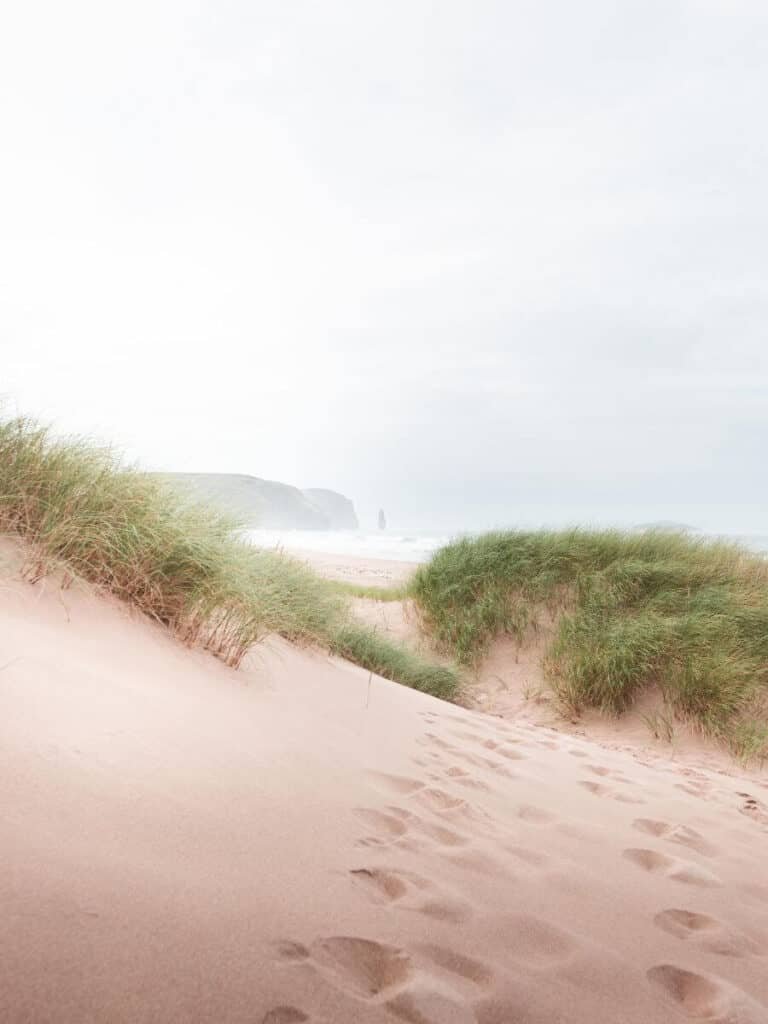
North Coast 500 Campsites
When planning your NC500 camping adventure, always book your campsites in advance, especially during peak season. While there are plenty of wild camping spots and areas suitable to park overnight, it’s often a necessity to use the facilities offered at a campsite.
Applecross Campsite
Location: Applecross, Wester Ross
Amenities: This scenic campsite offers pitches for tents, motorhomes, and caravans, along with electric hookups, laundry facilities, restrooms, showers, and Wi-Fi.
Pricing: Prices vary depending on the season and type of pitch, starting from £10 per adult per night.
Unique Selling Points: Situated near the famous Bealach na Bà mountain pass, this campsite boasts stunning views of the Inner Sound and the Isle of Skye. Enjoy local seafood at the nearby Applecross Inn or visit the beautiful Applecross Walled Garden.
Gairloch Caravan and Camping Site
Location: Gairloch, Wester Ross
Amenities: This well-maintained site offers tent and caravan pitches, electric hookups, laundry facilities, restrooms, showers, and an on-site shop.
Pricing: Prices start from £9 per adult per night.
Unique Selling Points: Located close to the charming village of Gairloch, this campsite provides easy access to local attractions such as the Gairloch Heritage Museum, Big Sand Beach, and the Beinn Eighe National Nature Reserve.
Clachtoll Beach Campsite
Location: Clachtoll, near Lochinver, Sutherland
Amenities: This beachside campsite features pitches for tents, motorhomes, caravans, electric hookups, restrooms, showers, laundry facilities, and Wi-Fi.
Pricing: Prices begin at £10 per adult per night.
Unique Selling Points: With direct access to the stunning Clachtoll Beach, this campsite is perfect for beach lovers and water sports enthusiasts. Explore the nearby Assynt coastal walk or visit the picturesque village of Lochinver.
Ardmair Point Holiday Centre
Location: Ullapool, Wester Ross
Amenities: This holiday centre offers pitches for tents, motorhomes, caravans, electric hookups, restrooms, showers, laundry facilities, a children’s play area, and Wi-Fi.
Pricing: Prices start from £10 per adult per night.
Unique Selling Points: Set against a stunning coastal backdrop, this campsite is just a short drive from the bustling fishing village of Ullapool. Visit the Ullapool Museum, enjoy local seafood, or take a scenic boat trip to the Summer Isles.
Sango Sands Oasis Campsite
Location: Durness, Sutherland
Amenities: This campsite offers pitches for tents, motorhomes, caravans, electric hookups, restrooms, showers, laundry facilities, and an on-site bar and restaurant.
Pricing: Prices begin at £9 per adult per night.
Unique Selling Points: Overlooking the beautiful Sango Bay, this campsite is within walking distance of Smoo Cave and Balnakeil Craft Village. Enjoy the breathtaking beaches of Durness and explore the rugged beauty of Cape Wrath.
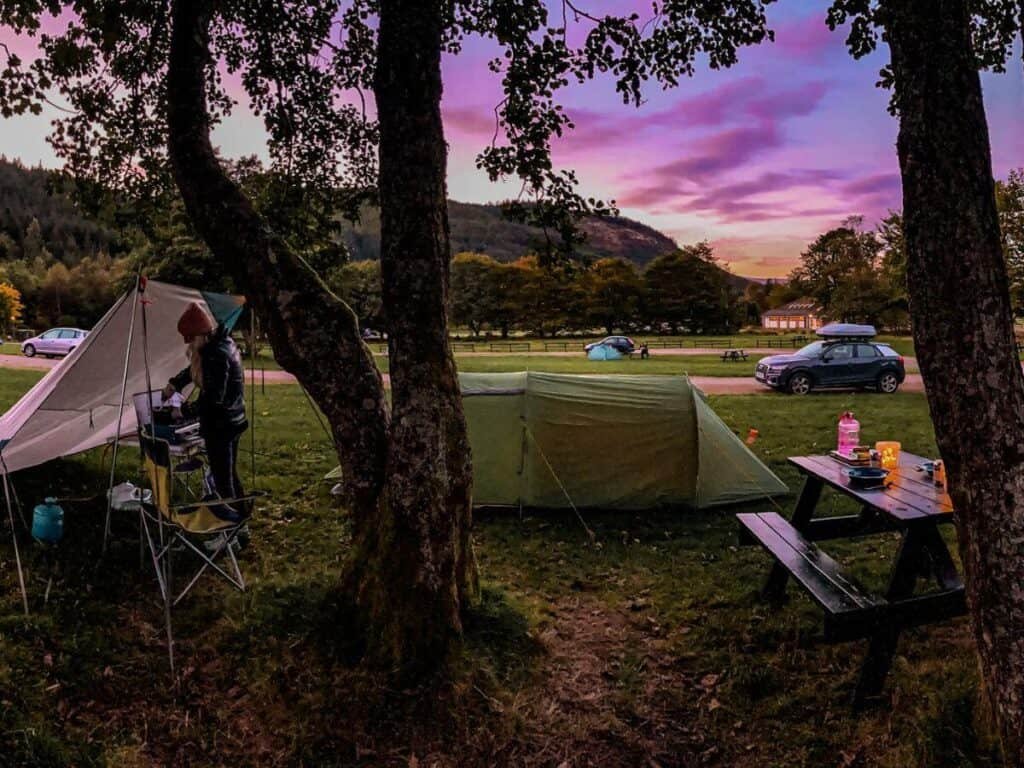
Tips for Your North Coast 500 Road Trip
If you plan to be on the road for over two weeks, plan for some downtime. You might get plenty if it rains a lot. But if you get lucky like we did and much of the trip is dry, active and jam-packed, you’ll be pretty tired.
Don’t burn out trying to fit everything in without breathing space. Sometimes just a lazy Netflix morning, a late cooked breakfast at a cafe or an afternoon start is enough to recharge your batteries.
- Book accommodations in advance, especially during peak season.
- Pack rain gear and layers, as the weather can be very unpredictable.
- Fuel up whenever possible, as petrol stations can be scarce in remote areas.
- Drive cautiously on single-track roads and use passing places to let other vehicles through.
- Respect the environment and follow the Scottish Outdoor Access Code.
Traditional Scottish Dishes To Try
Trying local dishes is a really important part of our travel experience, no matter how obscure some of them may seem. Many places now also have veggie options for meat-based traditional dishes.
To find the best places to eat, we ask locals or head to Google Maps for locations and reviews. The option to type in requests like “haggis near me” into Google Maps is such a huge time saver, not only do you get the closest options, but you also get their Google reviews.
If food is also a big part of your travel experience, don’t forget to add hunting down some of these dishes while creating your NC500 Itinerary.
Food For Your NC500 Itinerary
Haggis
Considered Scotland’s national dish, haggis is a savoury pudding made from sheep’s heart, liver, and lungs, minced with onion, oatmeal, suet, spices, and salt. It is traditionally encased in the sheep’s stomach and boiled, although modern versions may use artificial casings. Haggis is often served with neeps (turnips) and tatties (potatoes), and accompanied by a dram of Scotch whisky.
Cullen Skink
This hearty soup originates from the town of Cullen in the northeast of Scotland. It is made from smoked haddock, potatoes, and onions, cooked in a creamy broth. Cullen Skink is often enjoyed as a starter or a comforting main course on a cold day.
Scotch Pie
A popular snack in Scotland, Scotch pies are small, round, double-crusted meat pies typically filled with minced mutton or other meats. The crust is made from hot water pastry, making it firm and crispy, perfect for eating on the go.
Stovies
A traditional Scottish comfort food, stovies are a one-pot dish made from potatoes, onions, and leftover meat such as roast beef or lamb. The ingredients are slowly cooked together, creating a delicious, savoury dish often served with oatcakes or crusty bread.
Black Pudding
A type of blood sausage, black pudding is made from pork blood, oatmeal, and various spices. It is often served as part of a traditional Scottish breakfast or as an accompaniment to other dishes.
Cranachan
A classic Scottish dessert, cranachan is a delightful combination of whipped cream, honey, fresh raspberries, and toasted oatmeal, often flavoured with a splash of Scotch whisky. It is traditionally served in tall glasses and layered to create an appealing presentation.
Clootie Dumpling
This spiced fruit pudding is made by wrapping a mixture of flour, suet, sugar, spices, and dried fruits in a cloth (or “cloot”) and boiling it until cooked. Once cooled, the dumpling is turned out onto a plate and often served with custard or cream. Clootie dumpling is particularly popular during the festive season and on special occasions.
Fish Supper
If you’re after a traditional chippy* experience, you can opt for battered fish, a haggis fritter and chips. If you’re feeling really adventurous, you can finish with a can of Irn Bru and a battered Mars Bar for dessert.
*chippy, also known as chipper, is a traditional fish and chip shop.
NC500 Itinerary | The Ultimate Time And Route Planner
Crafting the perfect NC500 Itinerary is an exciting endeavour that allows you to experience the breathtaking beauty, rich history, and vibrant culture of the Scottish Highlands. By carefully selecting your destinations, prioritising popular attractions, and allocating sufficient time for exploration and relaxation, you’ll create a memorable journey that showcases the best of Scotland.
Remember to embrace the spontaneity of travel, allowing yourself the flexibility to savour unexpected discoveries along the way. As you embark on this unforgettable adventure, you’ll undoubtedly leave with a deeper appreciation for the enchanting landscapes and charming communities that grace the iconic North Coast 500 route.
